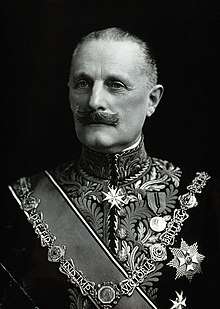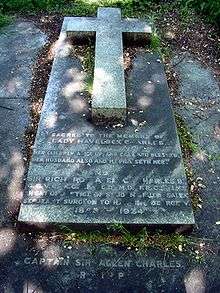Havelock Charles
Major-General Sir Richard Henry Havelock Charles, 1st Baronet, GCVO, KCSI (10 March 1858 – 27 October 1934) was a British doctor, and Serjeant Surgeon to King George V.
Sir Havelock Charles, Bt | |
|---|---|
 Sir Havelock Charles in the 1920s | |
| Born | 10 March 1858 |
| Died | 27 October 1934 (aged 76) |
| Allegiance | |
| Service/ | Indian Medical Service |
| Rank | Major-General |
| Awards | Knight Grand Cross of the Royal Victorian Order Knight Commander of the Order of the Star of India |
Early life and medical career
Charles was born in Cookstown, County Tyrone, the sixth son of David Hughes Charles MD and Annie Elizabeth Allen, and named after Sir Henry Havelock, who had died two months earlier. He was educated at Queen's College, Cork, before joining the Indian Medical Service as a surgeon in April 1882. In the year 1894, he was appointed as a Professor of Anatomy at the Medical College, Calcutta, and surgeon at the College Hospital.[1] On 1 April 1902 he was promoted to lieutenant-colonel,[2] and later attained the rank of major-general. During his tenure as a surgeon in the Medical College, Calcutta, he also served as the staff surgeon to the Prince of Wales (later George V during the latter's tour of India. Following this, Charles was appointed a Knight Commander of the Royal Victorian Order (KCVO) in 1906,[3] promoted to Knight Grand Cross (GCVO) in 1912[4] and was appointed a Knight Commander of the Order of the Star of India (KCSI) in 1923.[5]
Court appointment
On his return to India and upon ascension of George V to the throne, Charles was appointed Serjeant Surgeon to King George V from 1910–1928, and was later Honorary Serjeant Surgeon to His Majesty. He was created a Baronet, of The Abbey Grange, Waltham Abbey, in the County of Essex and of Manchester Square in the Parish of St Marylebone in the County of London, on 20 March 1928.[6]
Family
Charles married Gertrude Seton Gordon, and they had two children, Sir Allen Aitcheson Havelock Charles, 2nd Baronet, and Sir Noel Charles, 3rd Baronet.
He died at his home in Manchester Square, London W1, and is buried in Brompton Cemetery, London.

He was succeeded as 2nd Baronet by his son, Captain Sir Allen Aitcheson Havelock Charles, who established the Richard Havelock Charles Scholarships and Medals at Queen's University Belfast in his honour.
References
| Wikimedia Commons has media related to Sir Havelock Charles, 1st Baronet. |
- Hart´s Army list, 1903
- "No. 27444". The London Gazette. 20 June 1902. p. 4053.
- "No. 27913". The London Gazette. 15 May 1906. p. 3324.
- "No. 28580". The London Gazette. 13 February 1912. p. 1048.
- "No. 32782". The London Gazette (Supplement). 1 January 1923. p. 4.
- "No. 33343". The London Gazette (Supplement). 30 December 1927. pp. 1–2.
- Dictionary of Irish Biography
- Dictionary of Irish Biography: From the Earliest Times to the Year 2002, nine volumes, eds. James McGuire and James Quinn, Cambridge, 2009. ISBN 0-521-63331-1